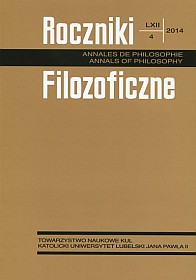The Issue of the “Occult Qualities” in the 17th-Century Discussions on the Nature of Material World
Abstract
The end of 16th and the beginning of 17th centuries witnessed some very heated discussions on the philosophy of nature. One of the important issues was the nature of matter. There clashed there the tree dominating philosophical positions—the Aristotelian hylemorphism, the emerging modern atomism and, deriving from Paracelsus the chemical philosophy. Of many of the discussed topics a special attention deserves the issue of “occult qualities.” The accepted concept of them turns out to be a distinguishing feature of these philosophical positions. The concept of “occult qualities” is an important one because it shows some epistemological presuppositions that are taken by each of the sides. It is mainly about the relation between intelligibility and possibility of sensual perception of material objects, and the cognitive abilities of human mind. The accepted views are decisive as to how the very concept of “quality” is understood. For the Aristotelians it is a feature that really adheres to the object, the modern philosophers understand it as a relation between the subject and the object, the Paracelsians, finally, interpret the features of material object in a spiritual way.
References
Descartes R.: Zasady filozofii, tł. I. Dąmbska, Kęty: Antyk 2001.
Doan M.: Paracelsus on ‘Erfahrung’ and the Wisdom of Praxis, „Analecta Hermeneutica” 1 (2009), s.167-183.
Hutchison K.: What Happened to Occult Qualities in the Scientific Revolution?, „Isis” 73 (1982), no. 2, s. 233-253.
Luethy C.H.: Atomism, Lynceus, and the Fate of Seventheenth-Century Microscop, „Early Science and Medicine” 1 (1996), s. 1-27.
Meinel Ch.: Early Seventeenth-Century Atomism: Theory, Epistemology, and the Insufficiency of Experiment, „Isis” 79 (1988), s. 68-103.
Siegfried R.: From Elements to Atoms: A History of Chemical Composition, Philadelphia: American Philosophical Society 2002.
Tomasz z Akwinu, św.: Summa teologiczna, t. VII, tł. P. Bełch, Londyn: Katolicki Ośrodek Wydawniczy „Veritas” 1980.
Titus Lucretius Carus, O naturze wszechrzeczy, tł. E Szymański, Kraków: PWN 1957.
Webster J.: From Paracelsus to Newton: Magic and the Making of Modern Science, Cambridge: Cambridge University Press 1982
Wilson C.: Visual Surface and Visual Symbol: The Microscope and the Occult in Early Modern Science, „Journal of the History of Ideas” 49 (1988), no. 1, s. 85-108.
Copyright (c) 2014 Roczniki Filozoficzne

This work is licensed under a Creative Commons Attribution-NonCommercial-NoDerivatives 4.0 International License.





